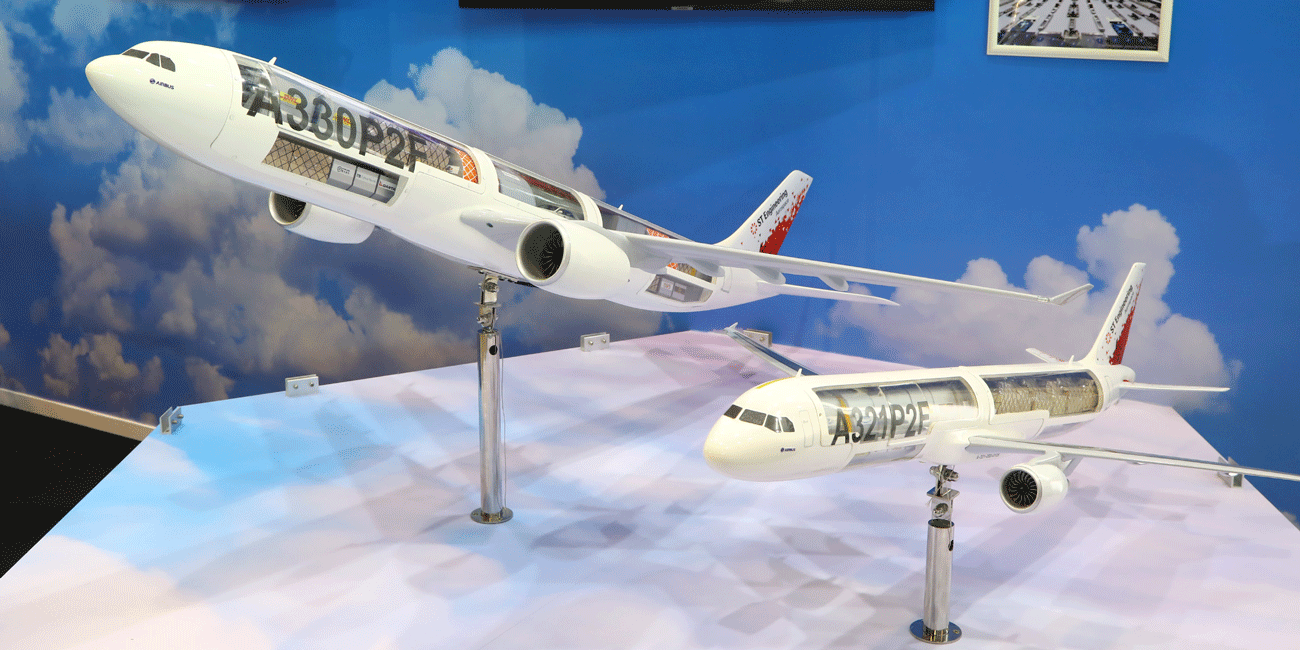Click Here to View This Page on Production Frontend
Click Here to Export Node Content
Click Here to View Printer-Friendly Version (Raw Backend)
Note: front-end display has links to styled print versions.
Content Node ID: 400640
ST Engineering has developed the Veloce, a fixed-wing vertical takeoff and landing UAV. There are two sizes of the Veloce, both displayed as full-scale models above the company’s usual large Singapore Airshow stand. Here, the great diversity of the Singapore company’s activities is apparent, divided into three clusters: Aviation, Defence, and Smart City.
Veloce is the latest in a long line of drones and UAVs from ST, most of which are in service, according to Chew Men Leong, chief marketing officer. The smaller Veloce 15 has a takeoff weight of 16-17 kg, a speed of 30-40 knots, a datalink range of up to 15 km, and a maximum endurance of three hours. The larger Veloce 60 has a takeoff weight of 50-70 kg, a speed of 50-70 knots, a datalink range of up to 70 km, and endurance of 12-14 hours.
Both are fully autonomous and equipped with an EO/IR payload. Their airframes both are equipped with four electrically-powered lift fans and pusher-propellers for forward flight. The Veloce 15 flies entirely on electrical power, whereas the Veloce 60 has a small conventional engine for forward flight. ST Engineering is suggesting a variety of missions, such as land surveys, riot control, reconnaissance, and search-and-rescue.
ST is big on the application of smart technology including artificial intelligence, especially for urban environments, such as autonomous electrically-powered buses and robotic forklift trucks; identity checking (border control and similar functions); and an unmanned rail-inspection vehicle. But although there are various VTOL mini-drones on display, chief marketing officer Chew said that ST is not developing small urban transport air vehicles, unlike many other companies. “There are still too many barriers to entry…we prefer to concentrate on small drones for logistics,” he said.
ST has refined the UAV control system that it exhibited here two years ago (DroNet) with automated remote stations with battery and sensor payload swapping mechanisms (DroPorts) and a centralized command and control center that can handle multiple drones, with capability for beyond line-of-sight operation (DroHub).
Like many companies now, ST offers counter-drone systems. A new one on display automatically detects and tracks single or multiple rotary drones and uses what is described as “a 40-mm airbursting precision technique to put up a streamer to take down drones.”
The company’s ST Aero division is a big player in passenger-to-freighter (P2F) conversions, airline cabin interiors, and MRO. Last month, it flew the A321-200 P2F conversion for the first time at Seletar airport. The program is a cooperation with EFW, the German P2F company that ST owns jointly with Airbus. ST expects to get the supplemental type certificate for the aircraft next month. Meanwhile, the company is hoping to do more A330 conversions. Six have been done so far, three each for DHL and Egypt Air.

Innovations in cabin interiors on display at this year's Singapore Airshow include a long-haul seat that uses a proprietary magnesium alloy rather than aluminum, saving 30 percent weight. A short-haul seat for narrowbodies named Spacelite II is claimed to be the lightest in its class, at just eight kilograms. Last but not least, ST is showing “a groundbreaking aircraft lavatory” that is designed to be 40 percent expandable so that it may be used by passengers with reduced mobility.
ST recently acquired Middle River Aerostructure Systems (MRAS) from GE. MRAS is a manufacturer of advanced engine nacelles, including for Comac’s C919 and ARJ21, and the Airbus A321neo.
Another recent acquisition has been the Newtec Group and Glowlink Communications Technology, which provide high-throughput satellite communications equipment with advanced anti-jamming capabilities. ST has been in the satellite business for some years and is now entering the microsatellite market. The NeuSar compact satetellite is being jointly developed with Singapore’s Defence Science Organisation and is equipped with synthetic aperture radar, which provides day and night imaging in all weather. The satellite weight just 190 kg and is due for launch in 2022.